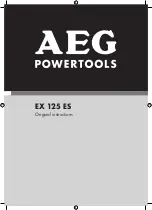
ADJUSTMENTS
HOLZMANN MASCHINEN GmbH www.holzmann-maschinen.at
27
BT 1220TOP
14.2
Operation
14.2.1
ON/OFF
To turn the machine on, press “I” (green).
To turn the machine off, press “O” (red).
14.2.2
Miter Gauge
The Miter Gauge (#110) can be used on the disc table, which
has a slot to fit the miter gauge’s bar. The miter gauge head can
be set anywhere up to 45º (right or left) by loosening the lock-
knob, setting the miter gauge head to the desired angle, and
retightening the lock-knob.
14.2.1
Horizontally / vertikally operation of belt sander
The sanding frame can be easily adjusted from a
horizontal position to a vertical position, or any other position to
assist your sanding operation.
1. Loosen the Hex Screw (#49) that pulls the split casting
together. This allow the sanding belt frame to be moved to the
work angle desired.
2. Once the sanding belt frame is at the desired work angle, re-
tighten the hex screw to secure it in place.
3. In the horizontal position, there are two vertical
padded Hex Screws (#32) that support the sanding belt frame.
These should be checked and adjusted, if necessary, to make
sure that they both touch the sanding frame Supports (#51).
These screws will help relieve pressure on the casting during
work.
14.2.2
Disc-Sanding
When sanding, always position your work on the downward,
rotating side (left side) of the sanding disc. The sanding action
will then force the wood down, safely towards the table, where it
can be controlled. Sanding on the right, upward rotating side of
the disc is dangerous, as your work cannot be controlled and
‘kick-back’ may occur - the wood being forced up and out of
your hands.
14.2.3
Belt-Sanding
1. Hold the work piece firmly, keeping fingers away from the
sanding belt.
2. Keep the work piece against the backstop and move it
evenly across the sanding belt. Use extra
caution when sanding very thin pieces. FIG. 33 & 34.
3. For sanding long pieces, remove the fence.
4. Do not force the work piece into the sanding belt. Sand
using light pressure, letting the sanding
abrasives time to do their work!
5. Move your work piece slightly left and right on the belt.
This will help prevent resin or debris from building up on one
area of the belt, and also helps to prevent burning of the
sanded surface from excessive abrasive-action heat build-
up.
SANDING CURVED EDGES
Sanding inside curves on your work piece and be done on
the idler drum as shown.
Summary of Contents for BT 1220TOP
Page 66: ......
















































